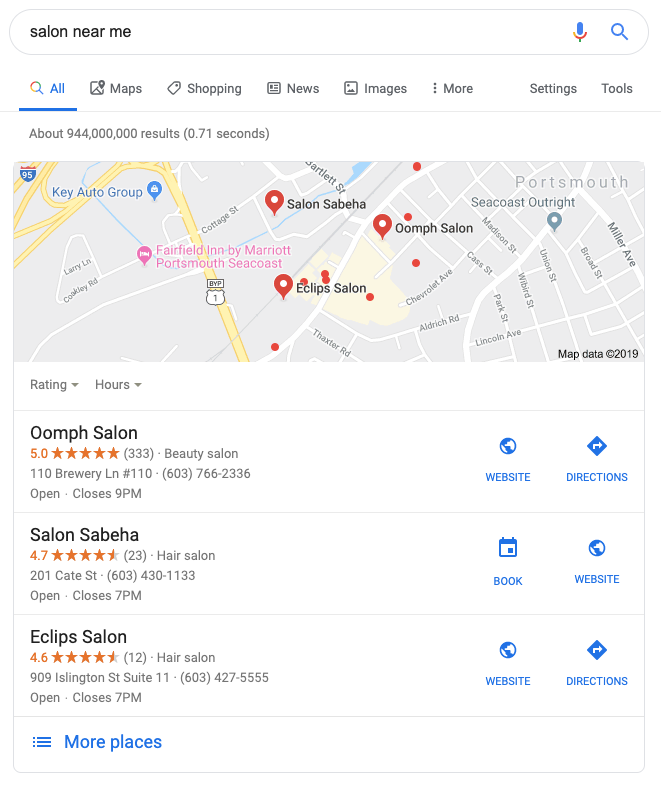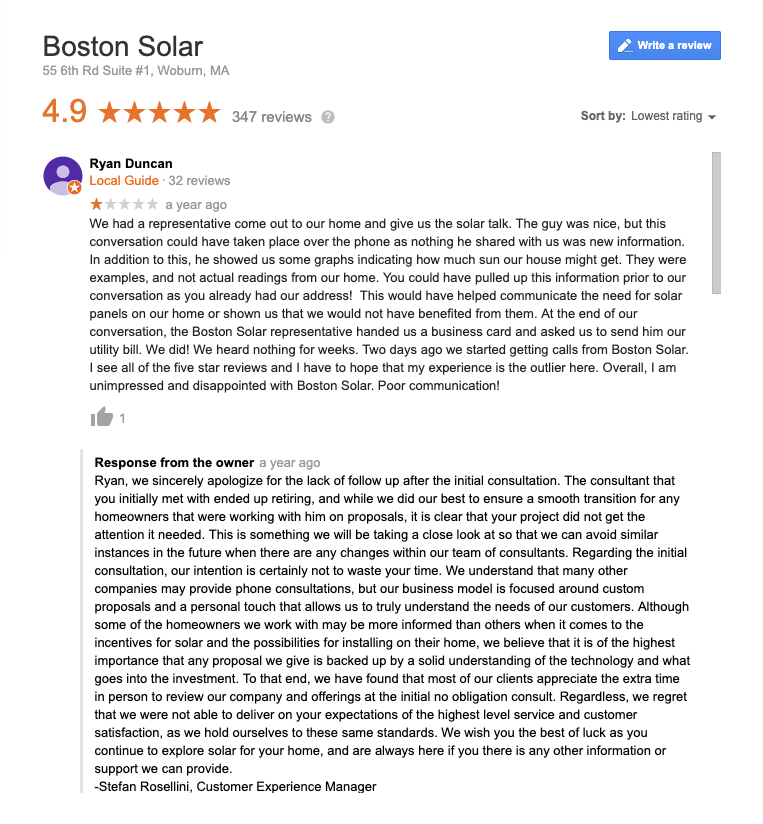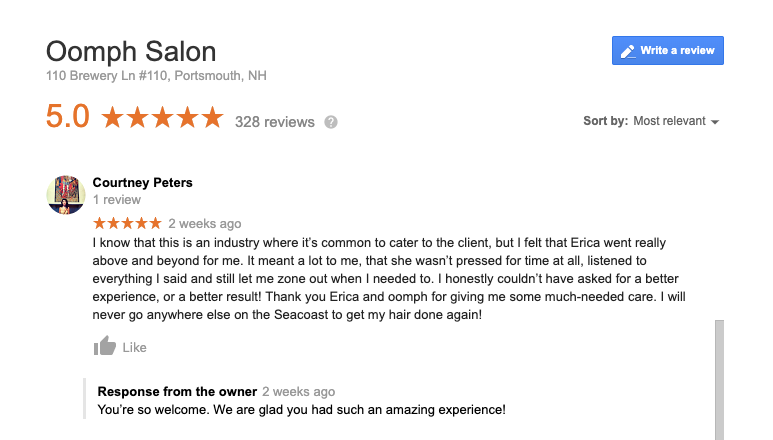Your company works hard to please the customer, to accommodate clients, and train employees to be friendly, helpful, and understanding when a customer loses her cool. But there will be times when someone walks away from your business unsatisfied. Unfortunately, it’s all too easy for them to shoot off a snide remark or a heated diatribe on one of the many review sites online today. You’ve worked hard to create a positive image of your company online through your inbound marketing efforts, so it’s understandable you’re worried when a bad review pops up that it could derail that effort.
Google My Business is a key part of local search and the reviews are one of the first things potential customers and clients will see when they search for your business name or the services your company provides. So what do you do if someone leaves a bad review on your company’s Google My Business page? Take a deep breath. We’ll walk you through it.
How bad is a bad Google My Business review?
There are dozens of ways a customer can give feedback about a company online, but the most popular service is Google My Business with an average of 150 million users a month. A lot of this traffic is due to Google being the largest search engine in the world. When someone leaves a review on your Google My Business account, it’s incorporated into all the various search result options Google offers, including the local pack. Every time someone searches for something “near me” and Google returns these reviews, they’re using Google My Business data.

While Google My Business has less name recognition than Yelp, for instance, it’s not a platform you want to ignore. According to a survey by Podium, 60% of consumers read online reviews at least once a week, and 93% said online reviews impact their purchasing decision. That’s pretty much everyone. With that much traffic on Google My Business, and that many people using online reviews to make purchasing decisions, monitoring your company’s account is a no-brainer.
Google My Business and inbound marketing
The first step is to make sure your Google My Business account is set up properly. Chances are if your business has been around for a few years or more, there is already a listing, you just need to claim it. Next, optimize your listing by filling in all the data. Search engines are looking for the most relevant results, and favor business listings with the most detailed and accurate information. Your listing should be accurate and tells potential customers exactly what your business does, where it is, and how they can get the products and services you offer. Upload a cover image, logo image, and any other pictures you think will encourage potential customers to contact you, and of course, don’t forget to add keywords relevant to your business.
Once you’re happy with your business account, see if there are any bad reviews left unaddressed. If there are, you can read further to learn how to address them. Finally, set up notifications so you or your marketing team can address future bad reviews quickly.
Why respond at all?
It may seem like responding to a bad online review is just adding fuel to the fire, but it’s an essential part of customer service today. People leave comments because they are unsatisfied and want to feel heard. Acknowledging their existence in a reply is a huge first step toward smoothing things over. Plus, it shows others you’re willing to go the distance to make customers happy. When potential customers see no response to a bad review, it tells them your company doesn’t care about customer service. Responding to reviews, both negative and positive, is essentially just another inbound marketing tactic you can use to show people your company is responsive, courteous, and organized.
Best practices for responding to a bad review
You may be tempted to fire off a snarky response the moment you read the review, especially if the reviewer is rude or misinformed about how your business works. Before you do, stop. Plenty of companies have made the damage from a bad review far worse by responding with emotion rather than taking a professional approach.
First investigate the claim
Employees will be your best resource for getting to the bottom of what caused the bad review. Find out who interacted with the reviewer. What is her side of the story? Are there receipts or paperwork that might help you get the full picture of what happened? Having this information helps you craft a thorough response, and will arm you in the event the reviewer is acting in bad faith.
Write a response offline
This may seem like an extra step, but writing your response offline, in a Word doc or whichever program you prefer, will give you a chance to slow down, look at the facts, and craft a measured response. Here is what you should include:
- Address the reviewer, preferably by name
- Mention you appreciate the feedback (even if it’s harsh)
- Acknowledge the person’s issue
- Give an explanation if there is a reason that caused the issue
- Offer a way to resolve it offline
Take this bad review left on the Google My Business page for Boston Solar. The customer was unsatisfied with his initial interactions with the business and complained they had poor communication. Below you can see a lengthy response, acknowledging the company dropped the ball a bit, but that it’s looking to fix similar situations in the future. It also explains the company’s process and leaves the door open for the customer to call. Then it closes with a signature from the Customer Experience Manager, so this reviewer knows exactly who responded, if he should want to follow up.

Scrolling through the reviews for Boston Solar, nearly all are positive. Those that are negative all have a response from someone at the company. This business didn’t get a 4.9-star rating by ignoring unhappy customers. It’s clear Boston Solar is willing to put in the work to deliver on their customer service.
Ask someone else to read it
Having another person read your response protects you against misunderstandings and needlessly upsetting the reviewer further. We’ve all shot off a text to someone who misinterpreted what we said, missed a typo, or were embarrassed by spell check. It only takes a second, but it can save you from further headaches.
Post it
Once you’re happy with your response, head to your company’s Google My Business page and find the post. You’ll want to reply directly to the review, as opposed to leaving a new review or comment. As you can see below in this rave review of my favorite Portsmouth salon, the owner thanked the reviewer in a reply, which shows up directly below the comment.

Speaking of rave reviews, responding to positive reviews, as well as negative ones, is a great inbound marketing tactic for building customer loyalty and creating brand evangelists. It shows customers and prospective customers you appreciate their recommendation and makes them feel like a valued customer. Seeing you are a responsive company also encourages others who are happy with their experience to leave a positive review.
Can’t I just remove them?
Google My Business has a process for removing erroneous reviews, such as a review that appears to be spammy or unrelated to your business. Unfortunately, the review is unlikely to be removed if the person who left it was a customer simply voicing unhappiness about your business.
Assuming the post is not spam or erroneous, respond and see if you can smooth things over first. If the issue is resolved, you can ask the customer to edit or remove the review. If this is not an option, you can flag the review. Here’s how:
- Sign into your Google My Business account.
- Choose your business location and click “Reviews” from the menu.
- Find the negative review you’d like removed, click the menu icon (three dots), then click “Flag” to mark as inappropriate.
Once flagged, it can take some time for Google to get around to reviewing the issue, so to speed up the process, contact support.
- In your Google My Business account, click “Menu,” scroll down, and look for “Support.”
- Within the popup, look for “Contact Us,” and click “Need More Help.”
- Choose “Customer Reviews and Photos.”
- Go to “Manage Customer Reviews.”
- Choose an option for communication: request callback, request chat, or email support.
Before flagging a review, ask yourself, was this review the result of some kind of misunderstanding, error, or substandard service? If so, it’s probably better to focus on addressing that problem than waiting for Google to make a decision on your request. After all, Google is likely to say no and then you’re back right where you started.
Want more positive reviews? Just ask!
Whether you’re a business owner, the marketing manager, or a customer service leader, you know how important it is to tell people how great you are. You also know that word-of-mouth and creating brand evangelists is a sign that your inbound marketing efforts have been successful. So why not encourage happy customers to spread the word? Customer recommendations are not new. Online reviews are just a different format. People today are used to being asked to weigh in on their experiences, whether it’s “liking” a business on Facebook or leaving a review. So why not ask?
Start with your most loyal customers. Explain you are trying to show people the quality of your services or products, and the kind of customer service people can expect. Because they are a valued customer, you would love a positive review from them. Be prepared to explain how to leave the review. Or make it easy for them and create a link that takes them directly where they need to go. You’d be surprised how many are happy to be asked, and how many are willing to share their experiences with others to support a business they love.






